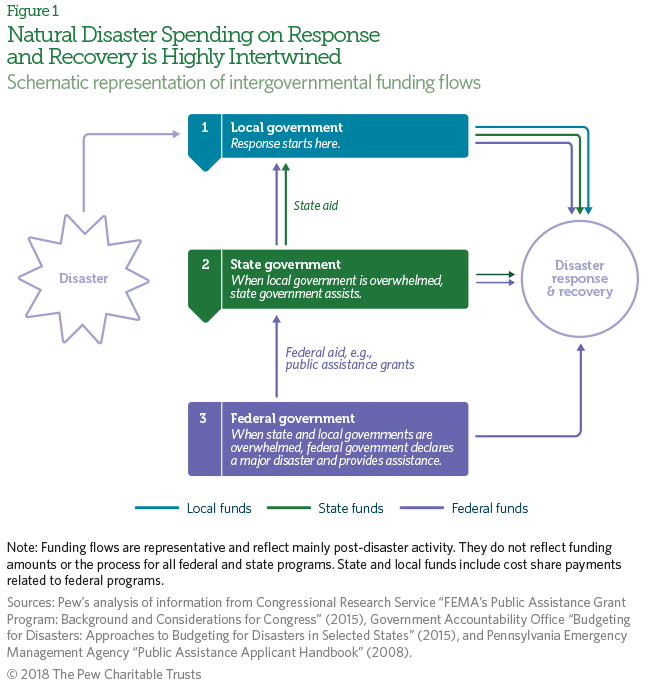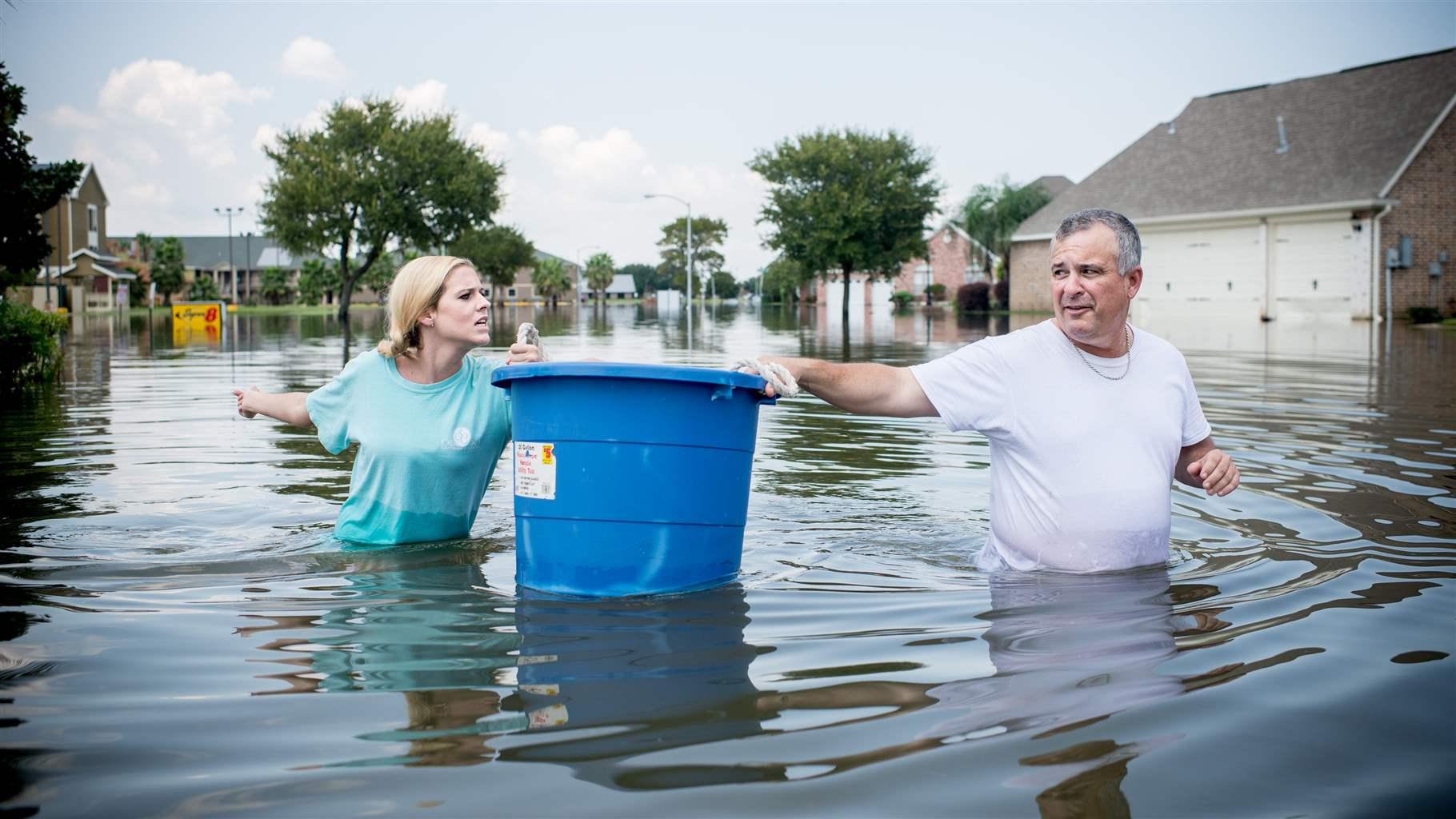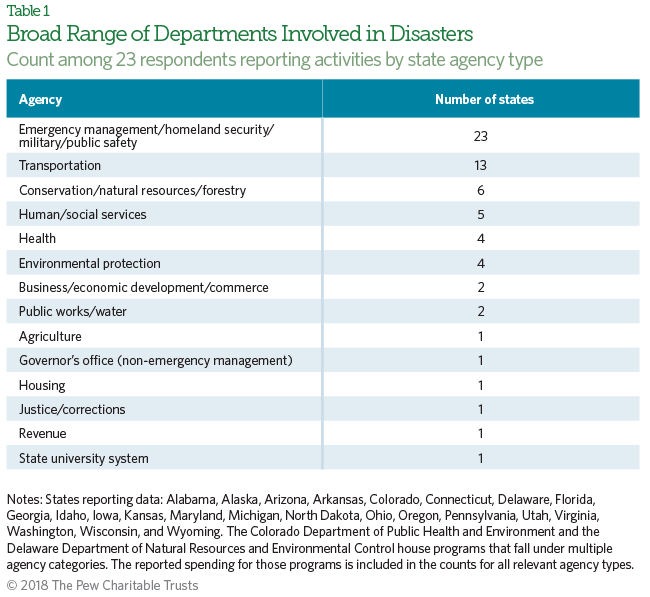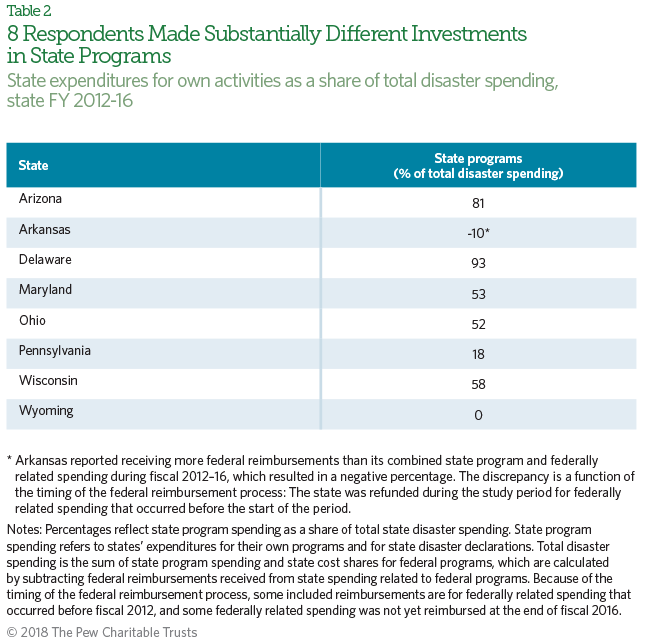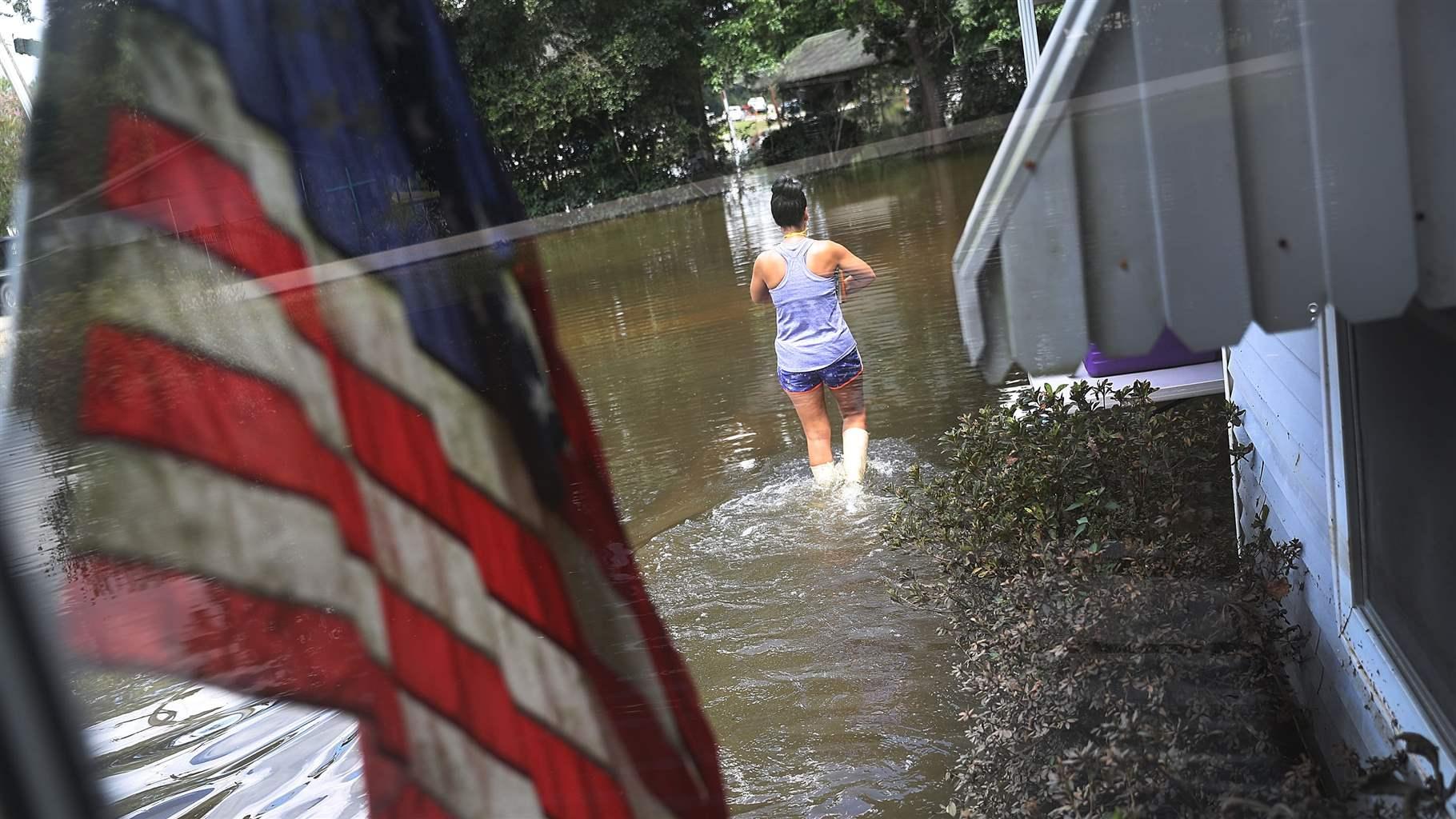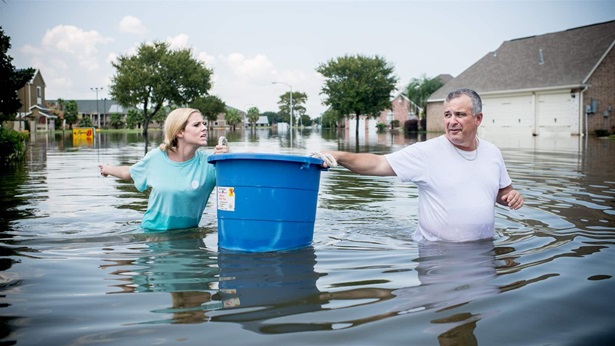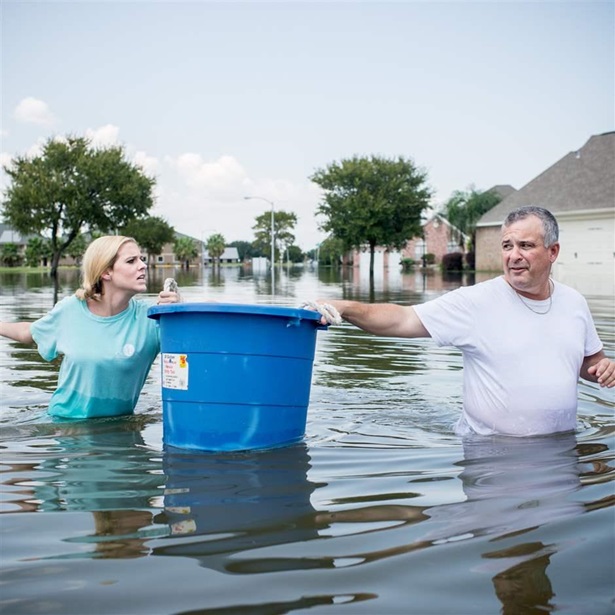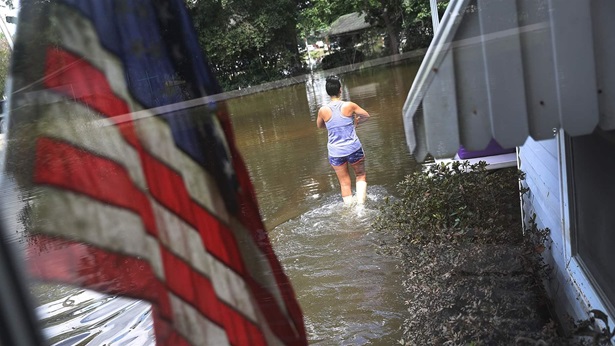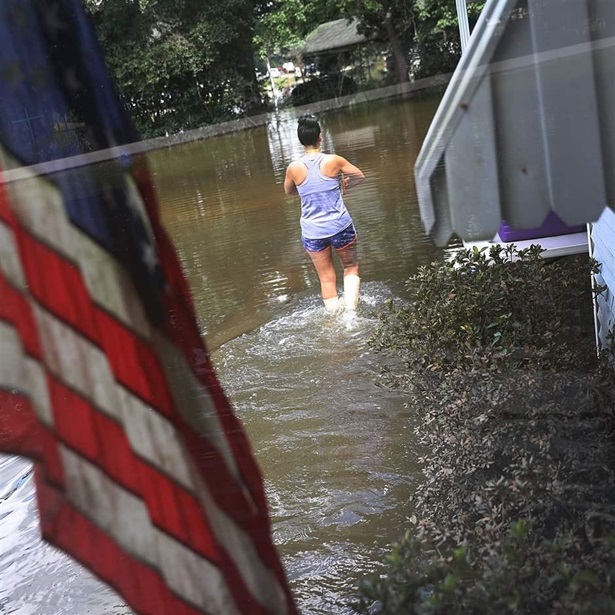What We Don't Know About State Spending on Natural Disasters Could Cost Us
Data limitations, their implications for policymaking, and strategies for improvement

Overview
Natural disaster assistance—helping communities be ready for and recover from events such as storms, earthquakes, and wildfires—involves an array of players from the public, for-profit, and nonprofit sectors. Central to those efforts is a complex intergovernmental partnership that is under stress from the increasing frequency and severity of losses and from budget constraints at all levels of government. The devastation wrought in 2017 by hurricanes Harvey, Irma, and Maria and wildfires in western states required unprecedented mobilizations to help communities in need: Local and state officials established shelters and activated emergency responders such as firefighters, police officers, and the National Guard; the federal government provided additional personnel, supplies, and funding. But addressing the immediate aftermath is just part of the job. Governments play a key role in all phases of disaster: mitigation, preparedness, response, and recovery.
Federal Emergency Management Agency (FEMA) leaders and other federal policymakers have expressed growing concern about the rising costs of natural disaster assistance. For example, FEMA’s public assistance (PA) program, which helps states and localities clear debris and rebuild infrastructure, had eight of its most expensive years in the decade between 2007 and 2016.
Congress and the Trump administration are considering several options to address increasing federal spending on these events, but they are doing so without comprehensive data on the contributions made by state and local governments. Making policy decisions without all the relevant information could result in changes that simply shift spending from one level of government to another or miss opportunities to encourage investment at all levels that could help manage growth in the nation’s total costs.
At the same time, state officials are concerned about not only rising costs but also federal proposals that do not reflect the full measure of their contributions. Wendy Smith-Reeve, deputy director of Arizona’s Department of Emergency and Military Affairs and past president of the National Emergency Management Association (NEMA), told The Washington Post in August 2017 that states need to do a better job showing the White House and Congress “what our investment is” for disasters.
To begin to fill this data gap, The Pew Charitable Trusts surveyed state emergency managers and their staffs requesting information on 2012-16 spending for state-funded disaster assistance programs, expenditures related to federal programs, and federal reimbursements received. Pew then determined each state’s total disaster spending by adding the two spending categories and reducing that figure by the reported reimbursement amount. The researchers also held follow-up discussions with states to clarify and refine their responses.
The key findings are:
- Most states do not comprehensively track natural disaster spending. The episodic nature of disasters generally means that policymakers struggle to maintain a focus on tracking of costs. Further, data collection can be difficult because numerous state agencies participate in various aspects of disaster assistance and they often report information differently.
- State spending is highly variable. Twenty-three states responded to Pew’s survey. Although the comprehensiveness of their data differed substantially, the submissions provided important insights into the diversity of states’ disaster spending, especially those from eight of the states, which worked with Pew to provide more complete information than the rest.
- Among those eight states, spending on state programs ranged from 93 percent of total state disaster spending in Delaware to zero in Wyoming.
- Five of those eight states reported investing in their own programs that mirror major FEMA post-disaster assistance programs for local governments and individuals. For example, Ohio and Arizona spent $11.2 million and $10.6 million, respectively, to help rebuild local infrastructure.
- Some states had their own mitigation programs—which reduce the damage from and cost of future disasters—such as North Dakota, which spent $226 million. Others reported spending on mitigation only as part of cost-sharing requirements for federal programs (states are obligated to pay a certain percentage of disaster expenditures to receive federal money).
- States take a range of approaches to sharing costs with local governments. For example, local governments in Pennsylvania must cover various percentages of federally required cost shares depending on the type of weather event, whereas in Oregon, locals are responsible for 100 percent.
Based on these findings, Pew recommends that state and federal policymakers make collecting comprehensive data a priority. Better data would inform debates about how much each level of government could pay and highlight opportunities to manage growth in overall costs. Gathering standardized information across numerous agencies within a state will require commitment from high-level officials, and getting data that are comparable across states will necessitate a coordinated national effort. Further, for that information to be most useful, it must be detailed enough to categorize spending by disaster phase, include specific information on mitigation (which research shows reduces future costs), and capture the ways in which states share costs with local governments.
Natural disaster spending is increasing, and experts expect that to continue, which in turn will spur more calls to address the distribution of expenditures across levels of government and to control rising overall costs. Any effort to adjust the federal-state disaster funding relationship should be grounded in comprehensive information about current spending, including all relevant agencies involved in disaster assistance. Collecting this information would ensure a better understanding of federal, state, and local capacity to respond to emergencies and could help identify targeted cost-saving incentives.
This report summarizes the complex nature of government disaster assistance funding and how rising federal costs are leading to calls for change, and outlines Pew’s findings and recommendations for improving the collection and usability of state spending data.
The 4 Phases of a Disaster |
* Malcolm E. Baird, “The ‘Phases’ of Emergency Management: Background Paper,” University of Memphis (2010), table 1, 16–19, http://www.memphis.edu/ifti/pdfs/cait_phases_of_emergency_mngt.pdf. |
A complex fiscal relationship among governments
A complex spending relationship underlies disaster assistance in the United States, involving all levels of government: local, state, and federal.1 The larger the natural disaster, the more likely all levels are to participate and spend significant amounts of money.2 And though major events that receive federal declarations get the most attention, state and local governments respond to many emergencies on their own. For example, the first responders are generally local governments using their own personnel and funding. But if the event exceeds that community’s capacity, the state steps in with its resources.
When disaster costs become too expensive for state and local governments to manage, governors can, under the Robert T. Stafford Disaster Relief and Emergency Assistance Act (Stafford Act), request a presidential declaration, which allows the federal government to provide supplemental resources and reimbursements for state and local costs. (See Figure 1.) The president can issue two main types of declarations—emergency and major disaster. Emergency declarations support immediate protection of lives, property, public health, and safety, while major disaster declarations make emergency and long-term funding available for events that have “caused damage of such severity that it is beyond the combined capabilities of state and local governments to respond.”3
The funding relationship between the federal government and states is highly interdependent. Federal investment in disaster assistance provides states with additional resources and can reduce their costs for federally declared disasters. One of the factors federal officials consider when determining whether to declare a major disaster and provide federal funds is a state’s capacity to respond.4
From federal fiscal years 2005 to 2014, all 50 states and the District of Columbia experienced disasters severe enough to trigger a federal emergency or major disaster declaration, including floods, hurricanes, severe storms, wildfires, and blizzards. Wyoming had the fewest, with just three declarations, and Oklahoma topped the list at 36.5 A declaration can unlock an array of federal assistance from many departments and agencies. More than 300 federal programs across 17 departments—including Homeland Security, which houses FEMA; Defense; Housing and Urban Development; Transportation; and Agriculture—together spent an average of $25.5 billion a year from 2005 to 2014 on disaster assistance after adjusting for inflation.6
During the same period, federal support to states through the largest of these programs, FEMA’s PA program for infrastructure reconstruction, ranged from $9 million in Wyoming to $15 billion in Louisiana.7 Further, eight of the most expensive years on record for the PA program were in the decade from 2007 to 2016.8
FEMA’s Public Assistance Grant Program |
|
The Federal Emergency Management Agency’s public assistance (PA) grant program is the agency’s largest disaster recovery program. Between federal fiscal years 2005 and 2014, it provided $45 billion in inflation-adjusted funds primarily to state and local governments to rebuild public infrastructure, with some portion available for mitigation projects.* The PA program is extremely complex, requiring extensive coordination among federal, state, and local governments. FEMA evaluates state requests for presidential disaster declarations, which are required before the agency can provide PA funding, and makes recommendations to the president, who has ultimate discretion. States often conduct a preliminary damage assessment in collaboration with FEMA to determine whether a presidential declaration is warranted and whether a state qualifies for PA based on six factors:†
Federal PA funding carries a cost share of 25 percent of recipients’ eligible expenditures. FEMA can cover more than 75 percent of costs if a governor makes, and the president approves, a specific request or if Congress directs the agency to do so.|| For major disasters that can be anticipated, such as hurricanes, some of the steps described above occur concurrently to facilitate prompt deployment of necessary resources at the local, state, and federal levels. * Pew's analysis of expenditure data from the Government Accountability Office, "Federal Disaster Assistance" † Federal Emergency Management Agency, “The Disaster Declaration Process,” accessed Nov. 3, 2017, https://www.fema.gov/disaster-declaration-process. ‡ Notice of Adjustment of Statewide Per Capita Impact Indicator, 82 Fed. Reg. 47554 (Oct. 12, 2017), https://www.gpo.gov/fdsys/granule/FR-2017-10-12/2017-22036. FEMA adjusts the per capita amount for inflation annually. § Federal Emergency Management Agency, “Public Assistance Per Capita Impact Indicator and Project Thresholds,” accessed Jan. 3, 2018, https://www.fema.gov/public-assistance-indicator-and-project-thresholds; Colorado Recovery and Resiliency Collaborative, “Local Government Guide to Recovery” (April 2017), 39, http://ccionline.org/download/Guide-to-Recovery-v.2-FINAL-4.18.2017.pdf. || Jared T. Brown and Daniel J. Richardson, “FEMA’s Public Assistance Grant Program: Background and Considerations for Congress,” Congressional Research Service (2015), 14, https://fas.org/sgp/crs/homesec/R43990.pdf. |
Reducing federal spending
Given the increase in federal disaster spending, Congress, the Department of Homeland Security’s Office of Inspector General, and the Government Accountability Office have called on FEMA to find ways to address the growing costs of natural disasters.9 For example, in early 2017, the FEMA Reauthorization Act was reintroduced in the U.S. House of Representatives with a provision requiring a comprehensive study of and recommendations for cutting costs across all levels of government.10 In response to these demands for cost reductions, FEMA has been considering several options to change the federal-state fiscal relationship, such as providing incentives for states and localities to invest in mitigation projects that decrease the likelihood of damage to structures.11
FEMA Administrator William B. “Brock” Long has repeatedly spoken about ensuring that states can handle their share of the costs, saying, for example: “We can’t afford to completely sustain or supplement programs through federal grants alone. … We have to have an honest conversation with states, with state and local governments, as to what is the right balance for sustaining programs in responding and recovery.”12
Among those concerned about rising costs, FEMA’s PA program has been a focus of attention and debate. One strategy that policymakers have discussed to reduce PA expenditures is increasing the threshold at which state costs would warrant a federal declaration and associated funding. Some experts argue that the threshold is too low and so has led to increased federal involvement in disaster assistance.13
FEMA has proposed a “Public Assistance Deductible” as an alternative to increasing the cost threshold or state share. Under this proposal, the agency would make PA funding contingent on states’ first spending a predetermined amount of their own money—similar to an insurance deductible payment.14 In conjunction with this requirement, FEMA would lower the deductible for states that implement mitigation measures, such as new building codes that help minimize damage and establishing reserve funds to cover disaster expenses.15 The effect on state spending of the deductible proposal is less clear than that of raising the threshold—which would probably increase state expenditures. But in comments, many state stakeholders expressed concerns that the deductible proposal would increase costs.16
As part of its focus on cost and damage reduction, FEMA has increasingly emphasized investments in mitigation, which have been shown to save an average of $6 in response and recovery spending for every $1 spent.17 In 2017, the agency’s Federal Insurance and Mitigation Administration launched its “Mitigation Moonshot,” with the goal of quadrupling mitigation spending by federal, state, local, and tribal governments; corporations; nonprofits; and private foundations by 2023.18 And most recently, Congress included a provision in its 2018 bipartisan budget agreement allowing the president to increase the federal government’s share of recovery costs from 75 to 85 percent for states that have invested in mitigation.19
State spending data missing from debate
Underlying much of the discussion and many federal reform proposals is the assumption that states are not contributing enough to disaster expenses. But this is difficult to assess because the available data on state spending are incomplete.
No single source provides comprehensive information about state spending. Some targeted efforts have yielded limited information about state budgeting, such as a 2015 GAO analysis that looked at practices of 10 states. In addition, NEMA produces a biennial study profiling state emergency management practices and how states fund selected programs and activities. Further, the National Association of State Budget Officers provided data on state disaster funds in its 2015 “Budget Processes in the States” report. However, missing from these studies is information on states’ actual expenditures by the many agencies involved in disaster assistance.20
To fill this information gap, Pew undertook a project, in collaboration with NEMA and other stakeholders, in late 2016 to collect data on state natural disaster spending for fiscal years 2012 through 2016. Using a standardized data collection tool, researchers asked state emergency management offices for information on:
- State program spending: Expenditures for state-funded programs and state disaster declarations.
- Federally related spending: Expenditures required to receive federal grants.
- Reimbursements received: Federal funding provided to states to refund certain federally related spending.
- Details on spending, including agency and disaster phase.
Pew used these data to calculate each state’s total disaster spending, adding expenditures on state programs to federal cost shares, which were determined by subtracting reimbursements received from federally related spending.21 (See the technical appendix for more information on Pew’s data collection method and calculations.)
Challenges in state disaster spending data
Pew received survey responses from 23 states, with varying levels of specificity. Eight of those states were able—through discussions with and assistance from Pew—to refine their data to support a more detailed analysis.22 A study of these data and conversations with respondents and stakeholders revealed two major findings regarding the federal-state funding relationship: States do not comprehensively track natural disaster spending, and state spending is highly variable.
Most states do not comprehensively track natural disaster spending
States face challenges in collecting complete and comparable disaster expenditure information, particularly coordinating record-keeping and reporting across many agencies and maintaining policymaker attention on tracking of disaster spending. However, Pew’s research did find that some states have structures in place that facilitate the tracking of quality data.
Multiple state agencies spend on disasters
As is the case with federal disaster spending, state disaster expenditures are generally spread across numerous agencies. State emergency management agencies are usually the largest players in natural disaster assistance, but various other departments may also be involved because of the many needs that arise, such as housing, health, environmental restoration, and economic development.23 States provided data on an array of entities, reflecting the breadth of statewide efforts in mitigation, preparedness, response, and recovery. (See Table 1.)
Having spending information from all involved agencies is essential to getting a full picture of a state’s disaster expenditures. Respondents to Pew’s survey noted that collecting data from across state government was difficult but critical to showing the true extent of investments. As Greg Wilz, retired deputy director of North Dakota’s Department of Emergency Services, explained, “Our challenge is getting numbers from other agencies, and frankly, with the hundreds of millions of dollars that are funded from or through other agencies, we cannot tell the North Dakota story with just [the emergency management agency] numbers alone.”24
States spend their own funds for disasters that are within their capacity to manage (i.e., those that do not warrant a federal declaration), to match ongoing federal grants—such as FEMA’s Emergency Management Performance Grant (EMPG), which supports preparedness activities—and to provide the cost share for federal assistance after a federal declaration. But how they disburse and record those monies can differ for many reasons. For example, financial staff members from Colorado’s emergency management agency could view spending information for other departments via the statewide financial system but could not gather comprehensive, standardized data because each agency coded its expenditures differently. In Florida, by contrast, the Division of Emergency Management reimburses agencies for their costs using a central fund and therefore has comparatively uniform records of most disaster-related spending in the state.25
Additionally, departments may track expenditures differently based on state or federal requirements, and some federal grant programs may be administered by state entities other than the emergency management agency. One state tracked expenditures by disaster declaration but not by year, limiting its ability to provide annual data, while another had recently changed accounting systems so it could not access historical data.
High-level attention and agency capacity are limited
Given the number of state agencies that provide some form of disaster assistance, comprehensive tracking would require a government-wide effort. But because disaster spending occurs episodically, it generally does not receive sustained attention from governors and state legislators who would need to lead such an endeavor. Most state policymakers recognize the importance of disaster preparedness, but they understandably direct most of their attention toward programs that require annual funding and make up the bulk of their budget, such as Medicaid and education. By comparison with these yearly commitments, knowing how much the state is investing in mitigation or may have to spend on the next emergency is simply not as pressing.
State emergency management agencies typically have the broadest understanding of which departments are involved in disaster assistance and often have established partnerships with other agencies that could be leveraged as part of a statewide information-gathering effort. Even with these advantages, however, agency staff in many states struggled to complete the data collection during the allotted time because of immediate mission-critical demands and resource constraints. For example, some agencies were busy responding to disasters or managing ongoing recovery efforts, and others were generally short-staffed and could not prioritize collecting and reporting the requested data.
Some states have coordinating bodies or processes that facilitate data collection
Some respondents in states were able to overcome certain challenges because their states had a coordinating body or centralized fund that enabled them to compile robust information. For example:
- Ohio leveraged interdepartmental contacts and relationships created through its State Recovery Partners, a group of 29 state agencies that participate in FEMA’s long-term recovery activities.26
- Arizona had a reporting system in place through its interagency Emergency Council, which reviews all disasters costing more than $200,000. The state emergency management agency also provides the council with a quarterly audit report verifying allocations and expenditures for disasters still in the response and recovery phases.27
- Michigan provided only a subset of the requested information, but department staff indicated that cross-agency spending could potentially be tracked because the state’s division of emergency management and homeland security reimburses other state agencies for disaster-related expenditures from a centralized fund.28
State spending is highly variable
Despite the challenges to tracking, the 23 survey responses that Pew received were sufficiently robust to show that states differ in the amount and composition of their disaster spending.
Makeup of state spending varies
Among the eight states with the most complete data, expenditures for their own programs ranged widely over the five-year period, from 93 percent of total disaster spending in Delaware to zero in Wyoming, with the balance directed to federal cost shares. (See Table 2.)
Many state programs mirror federal aid
Several states administer response and recovery programs for disasters that do not require federal intervention, most of which mirror FEMA’s PA program or its individual assistance (IA) program, which provides grants to families. NEMA’s 2016 biennial report found that 22 states operate their own PA programs and 10 run state-level IA programs.29 FEMA Administrator Long has said states should have “stand-alone individual assistance and public assistance programs” in addition to fully funding their emergency management agencies and rainy day funds.30
- Among respondents to Pew’s survey, five states reported having their own PA programs to help local governments rebuild public infrastructure. Over the five-year study period, total spending on those programs was as follows:
- Arizona: $10.6 million.
- Arkansas: $1.4 million.
- Ohio: $11.2 million.
- Pennsylvania: $6 million.
- Wisconsin: $4.9 million.
- Arkansas and Ohio also have state-level IA programs on which they spent $930,000 and $977,000, respectively, over those five years.
Some states invest their own funds in mitigation
Of the states that responded to Pew’s survey, most reported that the bulk of their mitigation spending was for cost shares required by federal programs such as FEMA’s Hazard Mitigation Grant Program (see “Primary Federal Grant Programs for Disaster Mitigation”), and some indicated no state-funded mitigation efforts. Additionally, in some states, local governments are responsible for the entirety of federal cost shares, meaning the state does not provide any of its own monies toward federal mitigation programs.
However, several respondents reported state-level investments in hazard mitigation during the five years examined:
- Arkansas invested more than $10 million in a program that provides reimbursements to property owners for tornado safe rooms and assistance to local governments for infrastructure improvements.
- Iowa established a statewide Flood Mitigation Board in 2012, which disbursed nearly $49 million for municipal mitigation projects.
- North Dakota’s State Water Commission spent nearly $226 million to support local flood control and property acquisition projects.
- Ohio spent $11 million on riverine flooding projects.
- Oregon’s Seismic Rehabilitation Grant Program invested nearly $36 million in earthquake retrofits for public structures.
Primary Federal Grant Programs for Disaster Mitigation |
|
The Hazard Mitigation Grant Program (HMGP) aims to reduce loss of life and property damage from future natural disasters by providing funding to state and local governments for mitigation projects after a major disaster declaration. The amount of funding a state receives for a declaration is 7.5 to 15 percent of the total disaster aid that FEMA grants the state for that disaster. For states with enhanced hazard mitigation plans, the maximum rises to 20 percent. In either case, the amount of disaster aid used to calculate the percentage is capped at $35 billion. States are obligated to pay a 25 percent cost share in order to receive funding.* HMGP funding totaled $6.1 billion from 2007 to 2016.† The Pre-Disaster Mitigation Grant Program provides grants to state and local governments to reduce overall risk to individuals and property from future disasters. All states receive some funding annually through a formula, and states wanting additional money must submit proposals to a competitive review process.‡ Both categories have a required 25 percent cost share.§ Funding for PDM was $529 million from 2007 to 2016.|| The Flood Mitigation Assistance Program aims to reduce or eliminate claims under the National Flood Insurance Program by providing competitive grants to state and local governments to develop plans and undertake projects to address flood risks.** Depending on the type of project, FEMA will cover between 75 and 100 percent of state costs.†† From 2007 to 2016, funding for FMA was $891 million.‡‡ * Natalie Paris Love, “FEMA’s Hazard Mitigation Grant Program: Overview and Issues,” Congressional Research Service (2009), https://digital.library.unt.edu/ark:/67531/metadc700922/m1/1/ high_res_d/R40471_2009Mar25.pdf. † Pew's analysis of data from the Federal Emergency Management Agency, "Hazard Mitigation Assistance Projects," accessed April 25, 2018, https://www.fema.gov/openfema-dataset-hazard-mitigation-assistance-projects-v1. Based on inflation-adjusted obligations for the 50 states and the District of Columbia, using federal fiscal years. ‡ Francis X. McCarthy and Natalie Keegan, “FEMA’s Pre-Disaster Mitigation Program: Overview and Issues,” Congressional Research Service (2009), https://fas.org/sgp/crs/homesec/RL34537.pdf. § Kim Rogers (pre-disaster mitigation program lead, federal insurance and mitigation administration, Federal Emergency Management Agency), email to The Pew Charitable Trusts, April 23, 2018. || Pew analysis of data from the Federal Emergency Management Agency, “Hazard Mitigation Assistance Pre‐Disaster Mitigation Data,” accessed Dec. 11, 2017, https://www.fema.gov/media-library/assets/documents/103341. ** Diane P. Horn and Jared T. Brown, “Introduction to the National Flood Insurance Program (NFIP),” Congressional Research Service (2018), 7–8, https://fas.org/sgp/crs/homesec/R44593.pdf. †† Federal Emergency Management Agency, “Hazard Mitigation Assistance Guidance: Hazard Mitigation Grant Program, Pre-Disaster Mitigation Program, and Flood Mitigation Assistance Program” (2015), 27, https://www.fema.gov/media-library-data/1424983165449-38f5dfc69c0bd4ea8a161e8bb7b79553/HMA_Guidance_022715_508.pdf. ‡‡ Pew's analysis of data from the Federal Emergency Management Agency, "Hazard Mitigation Assistance Projects." |
State approaches to sharing costs with local governments
Pew’s survey results align with previous research showing that states take many approaches to splitting cost shares for FEMA programs—as well as those from other federal agencies and departments—with local governments. For FEMA’s PA program, NEMA found that 40 states pay at least some of the match: Four states and the District of Columbia cover the whole amount, seven split it evenly with localities, 10 divide it unevenly, and the rest had other arrangements, such as in New Jersey, where state and local obligations are determined on a case-by-case basis.31 Survey respondents provided additional examples:
- Pennsylvania pays all FEMA PA cost shares except those for snow-related events, which are covered by localities.
- In Oregon, local governments pay the entire federal cost share for FEMA’s PA program, but the match for the agency’s EMPG is split between the state and localities, according to the proportion of funding each receives. Several other states also used this approach to the EMPG.32
- Similarly, states varied in how they divided with local governments the cost share (of up to 20 percent) for the Federal Highway Administration’s Emergency Relief program, which pays for disaster damages to major roads and highways.33 For example, in Ohio, the local share varies depending on the timeline of the specific project, whether the repairs are to state or local roadways, and case-by-case instances in which the state supports local projects. In Arizona, locals do not pay any portion for repairs that occur within 180 days of the disaster; after that time frame, they pay 5.3 percent.
Strategies to improve the available information
The lack of comprehensive expenditure tracking among states and the wide variation in spending have important implications for federal and state efforts to address rising natural disaster costs. Policymakers at all levels of government are missing information they need to make data-driven decisions about disaster assistance funding. Better tracking at the state level would reveal the extent of investments across agencies and phases of disaster; it would also support strategic decisions about funding of cost-saving mitigation measures. And if federal policymakers had thorough, reliable, comparable 50-state data, they would know how state expenditures align with federal goals and could anticipate how changes to federal policy would affect individual states. For example, the available data show that some states are already participating in the types of activities that FEMA is encouraging, such as independently funding state programs and mitigation.
To meet federal and state informational needs, Pew recommends that policymakers at both levels of government make a commitment to improve data collection, document spending by disaster phase, and ensure that tracking efforts include local spending.
Commit to better data collection
Because disaster spending is often spread across many state agencies, efforts to collect comprehensive, timely data will require sustained interest and commitment from high-level state policymakers—particularly governors and legislative leaders. Although state emergency management offices are the primary points of contact and the coordinating bodies for many disaster activities, they generally do not have authority to view or request spending information from other agencies. One state emergency management staff member noted that gathering, evaluating, and consolidating data from multiple agencies would require coordination from within the governor’s office.
And although having a champion within state government is essential for data collection at the individual state level, acquiring comparable spending data from all 50 states would probably need to be a coordinated national effort.
Track spending by phase, with a focus on mitigation
Because states do not know how much they spend on disasters in total, they do not have a complete picture of their funding by phase and cannot accurately gauge their proactive mitigation investments versus post-disaster response and recovery expenditures. FEMA’s primary mitigation programs accounted for only 2 percent of federal funding committed to disasters between 2005 and 2014, but without comprehensive state-level data categorized by phase of disaster, the percentage of individual—or all—states’ disaster spending that is dedicated to cost-saving mitigation measures cannot be calculated.34 States would benefit from collecting data that documents spending on pre-emptive activities, because research shows that every $1 invested in mitigation reduces future costs by $6 on average.35
State spending data classified by disaster phase would also enable federal policymakers to accurately identify existing state activities that would qualify for federal incentives or advance strategic federal goals. For example, because FEMA’s Mitigation Moonshot aims to quadruple state mitigation investments by 2023, it needs a state-level investment benchmark against which to measure that goal. FEMA has also sought to encourage state-funded mitigation activities under the PA deductible proposal and in its 2018-22 strategic plan.36 Further, in early 2018, FEMA’s Mitigation Framework Leadership Group, a federal interagency coordinating body, released its National Mitigation Investment Strategy, which calls for the “vast majority” of mitigation efforts to come from the state and local levels.37
Account for local spending
Although states are the principal gatekeepers for federal disaster funds and provide significant resources for response and recovery, local governments also commit critical funding for all phases of a disaster. Any attempt to collect state spending data should incorporate information about how states and local governments divide costs and how much each contributes because whether a state pays the entire cost share for federal programs, splits it with local governments, or pays no portion will be key to determining how proposed changes to federal funding will affect that state’s budget. For instance, if the federal government offered a reduced cost share as a reward for increased state-level mitigation investments, states in which local governments pay 100 percent of that cost share would receive no credit for that local spending. A more comprehensive view of how states handle these expenses in conjunction with their local partners is vital to well-informed policy change at the federal level.
Conclusion
In an era of increasingly expensive disasters, efforts to adjust the funding relationship among the federal, state, and local levels and manage growing costs through mitigation are likely to increase. However, Pew’s research shows that states are not comprehensively tracking their disaster spending. The limited available state data strongly indicate that these expenditures vary widely across states. Without complete data about state investments and local cost-sharing practices, any proposal tackling intergovernmental spending issues or cost reduction will be operating largely in the dark.
As federal efforts take shape in the context of increasing expenditures on all disaster phases, a commitment from state and federal policymakers to collect and share comprehensive data is critical. Understanding the full scope of spending on natural disasters will help leaders at all levels of government as they work to control the growing costs of these events in dollars, property losses, and lives.
Download the report to read the technical appendix and methodology.
Endnotes
- Nongovernment entities such as charities, nonprofits, religious institutions, and private businesses also play important roles in disaster relief. For more information, see Foundation Center and the Center for Disaster Philanthropy, “Measuring the State of Disaster Philanthropy 2017” (2017), http://disasterphilanthropy.foundationcenter.org. One key partner is the American Red Cross, a nonprofit with a congressionally approved charter that allows the federal government to assign responsibilities to and, when necessary, provide appropriations for the organization during a disaster. For more information see “Our Federal Charter: How the American Red Cross Achieved Its Current Role,” accessed March 30, 2018, http://embed.widencdn.net/pdf/plus/americanredcross/e5mfayep2z/history-federal-charter.pdf?u=0aormr. Additional intergovernmental relationships exist between the federal government and sovereign tribes and U.S. territories.
- The United Nations Office for Disaster Risk Reduction has suggested that rather than “natural disasters,” there are natural hazards and events that result in disasters that affect societies and the environment. This report uses the term “natural disaster” because it is still frequently used in statute and common parlance. See United Nations Office for Disaster Risk Reduction, “What Is Disaster Risk Reduction?” accessed March 2, 2018, https://www.unisdr.org/who-we-are/what-is-drr.
- Bruce R. Lindsay and Jaclyn Petruzzelli, “Preliminary Damage Assessments for Major Disasters: Overview, Analysis, and Policy Observations,” Congressional Research Service (2017), 1. The Stafford Act sets a $5 million cap on federal funding for emergency declarations. That maximum can be raised, but the president must notify Congress. See Federal Emergency Management Agency, “Fact Sheet: Disaster Declaration Process,” accessed March 1, 2018, https://www.fema.gov/pdf/media/factsheets/dad_disaster_declaration.pdf.
- Code of Federal Regulations, Federal Disaster Assistance, title 44, sec. 206.48.
- Pew analysis of Federal Emergency Management Agency data on disaster declarations. This count does not include Fire Management Assistance Grant (FMAG) declarations because they account for a small portion of spending compared with emergency and major disaster declarations, at just 1.3 percent of expenditures from the federal Disaster Relief Fund between fiscal 2006 and 2015, according to a Congressional Research Service analysis. FMAG declarations can be approved on an expedited basis at the FEMA regional administrator level and are intended to control fires that have the potential to cause major-disaster-level damage. See Bruce R. Lindsay et al., “Fire Management Assistance Grants: Frequently Asked Questions,” Congressional Research Service, accessed Aug. 29, 2017, https://www.hsdl.org/?view&did=758603.
- Pew's analysis of data from the Government Accountability Office, “Federal Disaster Assistance” (September 2016), http://www.gao.gov/products/GAO-16-797. Based on Pew calculations, inflation-adjusted. In response to a 2014 congressional request, the GAO undertook an analysis of federal disaster programs, which included funds made available through annual and supplemental appropriations for natural, man-made, and public health-related incidents. The report found that 33 agencies received funding from the Disaster Relief Fund (DRF) from fiscal 2005 to 2014 but focused on the 17 departments and agencies that had significant expenditures for disasters from their own funds as well as the DRF. For more information, see The Pew Charitable Trusts, “Federal Disaster Assistance Goes Beyond FEMA,” Sept. 29, 2017, http://www.pewtrusts.org/en/research-and-analysis/fact-sheets/2017/09/federal-disaster-assistance-goes-beyond-fema.
- Pew analysis of Federal Emergency Management Agency data on Public Assistance obligations, received Feb. 2, 2018, via Freedom of Information Act request.
- Ibid. This figure includes natural disasters in the 50 states and the District of Columbia since 1987 and uses federal fiscal years. It does not include spending related to man-made disasters, such as the 9/11 terrorist attacks, that occurred during that period.
- U.S. Department of Homeland Security Office of Inspector General, “Opportunities to Improve FEMA’s Public Assistance Preliminary Damage Assessment Process” (May 2012), https://www.oig.dhs.gov/assets/Mgmt/2012/OIG_12-79_May12.pdf; Government Accountability Office, “Federal Disaster Assistance: Improved Criteria Needed to Assess a Jurisdiction’s Capability to Respond and Recover on Its Own” (September 2012), http://www.gao.gov/assets/650/648162.pdf.
- FEMA Reauthorization Act of 2017, H.R. 2548, 115th Cong. (2017–18), https://www.congress.gov/bill/115th-congress/house-bill/2548?q=%7B%22search%22%3A%5B%22hr2548%22%5D%7D&r=1.
- Proposed Rule No. 2017-00467, 82 Fed. Reg. 4064-4097 (Jan. 12, 2007), https://www.federalregister.gov/documents/2017/01/12/2017-00467/establishing-a-deductible-for-femas-public-assistance-program.
- Tim Craig, “Massive Wildfires Turned Prairies to Ash, Leading Montana’s Cowboys to Weigh Federal Help,” The Washington Post, Aug. 13, 2017, https://www.washingtonpost.com/national/massive-wildfires-turned-prairies-to-ash-leading-montanas-cowboys-to-weigh-federal-help/2017/08/13/a3b4464a-786a-11e7-8f39-eeb7d3a2d304_story.html?utm_term=.f3ff5498edf4.
- Proposed Rule No. 2017-00467; Tom Coburn, “An Imperfect Storm: How Outdated Federal Rules Distort the Disaster Declaration Process and Fleece Taxpayers,” U.S. Senate Homeland Security and Government Affairs Committee (2014),https://hazdoc.colorado.edu/bitstream/handle/10590/2747/C023172.pdf?sequence=1; Government Accountability Office, “Federal Disaster Assistance: Improved Criteria Needed.”
- Federal assistance for immediate needs such as rescue and debris removal is not subject to the deductible.
- For more information, see Proposed Rule No. 2017-00467.
- Comment submitted by Trina Sheets, National Emergency Management Association, Docket ID: FEMA-2016-0003-0189, April 12, 2017, https://www.regulations.gov/document?D=FEMA-2016-0003-0189; comment submitted by National Conference of State Legislatures, Docket ID: FEMA-2016-0003-0220, April 12, 2017, https://www.regulations.gov/document?D=FEMA-2016-0003-0220. See also state-specific public comments to Proposed Rule No. 2017-00467, https://www.federalregister.gov/documents/2016/01/20/2016-00997/establishing-a-deductible-for-femas-public-assistance-program.
- National Institute of Building Sciences, “Natural Hazard Mitigation Saves: 2017 Interim Report” (2017), https://www.nibs.org/page/mitigationsaves.
- Federal Emergency Management Agency, “FEMA National Advisory Council May 2017 Meeting Minutes,” accessed Dec. 5, 2017, https://www.fema.gov/media-library-data/1501859547272-a1fd534c002b3fa131d3844fd2eeafaf/2017.05_MeetingMinutes_FINAL(508).pdf; Nick Shufro (assistant administrator, risk management, federal insurance and mitigation administration, Federal Emergency Management Agency), conversation with The Pew Charitable Trusts, Oct. 10, 2017.
- Bipartisan Budget Act of 2018, H.R. 1892, 115th Cong. (2017–18), https://www.congress.gov/bill/115th-congress/house-bill/1892/text?q=%7B%22search%22%3A%5B%22bipartisan+budget+acts+2018%22%5D%7D&r=1. The legislation offers the increased federal share for measures such as enacting a mitigation plan, investing in disaster-related programs and insurance, adopting and enforcing building codes, participating in a voluntary federal flood management program, and funding mitigation projects, including through tax incentives.
- Government Accountability Office, “Budgeting for Disasters: Approaches to Budgeting for Disasters in Selected States” (March 2015), https://www.gao.gov/products/GAO-15-424; National Emergency Management Association, “2016 NEMA Biennial Report” (2016), https://www.nemaweb.org/index.php/resources/online-store/product/38-2016-nema-biennial-report-digital-version; National Association of State Budget Officers, “Budget Processes in the States” (2015), https://higherlogicdownload.s3.amazonaws.com/NASBO/9d2d2db1-c943-4f1b-b750-0fca152d64c2/UploadedImages/Budget%20Processess/2015_Budget_Processes_-_S.pdf; Proposed Rule No. 2017-00467.
- Pew’s survey requested that states report actual expenditures, but some FEMA data were reported as commitments or obligations and some as final expenditures. States reported spending by their individual fiscal years.
- Pew researchers provided written questions to states to clarify data that was ambiguous and followed up with one or more interview sessions to further refine specific spending figures and descriptions of those figures used in this report. The eight states were Arizona, Arkansas, Delaware, Maryland, Ohio, Pennsylvania, Wisconsin, and Wyoming. For state data used in this report from the other 14 states, individual data points were verified before publication. For more information see the technical appendix.
- In South Carolina, for example, emergency management is under the Adjutant General’s office. The state’s Department of Natural Resources administers the federal National Flood Insurance Program and flood mitigation programs. Mitigation related to hurricane wind is under the jurisdiction of the Emergency Management Division and the Department of Insurance, which funds state-appropriated expenditures. Finally, a separate State Recovery Office was created in the Department of Insurance in 2015 to handle long-term HUD funding through the Community Development Block Grant Disaster Relief program. Details provided by: Susan Cutter, Carolina distinguished professor and director, Hazards and Vulnerability Research Institute, University of South Carolina, comment to The Pew Charitable Trusts, Feb. 15, 2018.
- Greg Wilz (retired deputy director, North Dakota Department of Emergency Services), email to The Pew Charitable Trusts, June 22, 2017.
- Electra Theodorides-Bustle (chief of staff, Colorado Division of Homeland Security and Emergency Management), phone call with The Pew Charitable Trusts, Aug. 16, 2017; Bill Archambault (senior program manager, Colorado Division of Homeland Security and Emergency Management), email to The Pew Charitable Trusts, Feb. 23, 2018. The ability to view other departments’ expenditure data became possible in July 2014 with the implementation of a new financial system; Susanne McDaniel (planning and budget manager, Florida Division of Emergency Management), conversation with The Pew Charitable Trusts, July 26, 2016.
- Laura Adcock (disaster recovery branch chief, Ohio Emergency Management Agency), conversation with The Pew Charitable Trusts, Aug. 24, 2017.
- Darlene Quihuis (public assistance/finance specialist, Arizona Division of Emergency Management), conversation with The Pew Charitable Trusts, Aug. 24, 2017.
- Capt. Chris A. Kelenske (deputy state director of emergency management and homeland security, Michigan State Police), conversation with The Pew Charitable Trusts, Aug. 25, 2017.
- National Emergency Management Association, “2016 NEMA Biennial Report,” 32–34. Public assistance states: Alabama, Alaska, Arizona, Arkansas, California, Idaho, Indiana, Maine, Michigan, Minnesota, Montana, Nebraska, New Mexico, North Carolina, North Dakota, Ohio, Oklahoma, Pennsylvania, Utah, Vermont, Virginia, and Wisconsin; individual assistance states: Alaska, Arkansas, California, Colorado, Indiana, Iowa, Maine, North Carolina, Ohio, and Oregon. NEMA’s survey includes the U.S. Virgin Islands and Guam, which Pew did not include in this report.
- Julia Manchester, “FEMA Chief: Harvey a ‘Wake-Up Call’ for State, Local Officials,” The Hill, Sept. 3, 2017, http://thehill.com/homenews/sunday-talk-shows/349047-fema-states-need-self-sufficiency-in-disasters.
- National Emergency Management Association, “2016 NEMA Biennial Report,” 10–11. NEMA’s count of states includes Guam and the U.S. Virgin Islands, which are not included in the count used in this report.
- State funds are used to cover the cost share if the recipient of PA funding is an Oregon state agency rather than a local government.
- Federal Highway Administration, “Emergency Relief Manual (Federal-Aid Highways)” (May 2013), 46–47, https://www.fhwa.dot.gov/reports/erm/er.pdf.
-
Pew's analysis of data from the Government Accountability Office, “Federal Disaster Assistance.” The mitigation programs included in the 2 percent figure are FEMA’s Hazard Mitigation Grant Program, Pre-Disaster Mitigation, and Flood Mitigation Assistance. While other programs may provide funding for mitigation projects, GAO’s report did not categorize programs by phase of disaster.
- National Institute of Building Sciences, “Natural Hazard Mitigation Saves.”
- Federal Emergency Management Agency, “2018–2022 Strategic Plan” (2018), 13, https://www.fema.gov/media-library/assets/documents/160940.
- Federal Emergency Management Agency, Mitigation Framework Leadership Group, “Draft National Mitigation Investment Strategy for Public Comment,” Jan. 11, 2018, 25, https://www.fema.gov/media-library-data/1515688801146-ef9a42945d292dc6848dc4390dc0b032/Draft-National-Investment-Strategy-for-Public-Comment_Jan2018.pdf.

